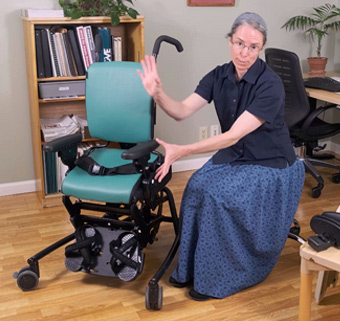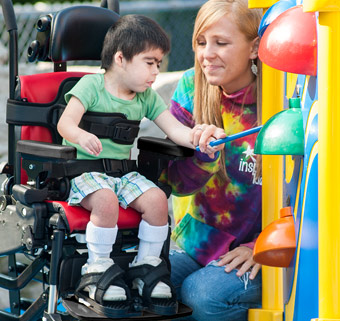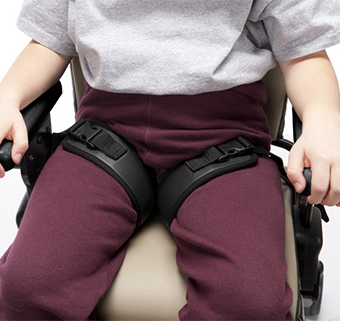Rifton Anchors: Facilitate Positioning to Develop Sitting Skills
By Marisol M. Enriquez, PT P138 @ J47 NYC-DOE Public Schools, New York, NY
| August 2008At our site, the Rifton Anchors are essential aids in achieving optimal goals for the enhancement of students’ functional performance in school, and produce a positive effect on their daily lives.
Anchors serve as effective tools in assisting students to sustain better control of their extremities, head and trunk. They are great stabilizers for positioning kids in upright sitting, enabling the firing of postural muscles of the head and trunk. When used as a short-term positioning aid, Anchors make a remarkable difference in the child’s mobility and independence. The Anchor allows freedom of motion for the head and upper extremity while stimulating the trunk synergistically to gain better control over a certain anti-gravity position.
 Anchors are important tools because they enhance the development of the shoulder girdle, back, neck and abdominal muscles, thus increasing a child’s level of independence. The Anchor transforms an ordinary sitting activity in a manner that allows a higher degree of involvement of the child for social interaction and physical work. Kids with weak trunk muscles will improve their sitting balance when the upper extremities are stabilized with Anchors. The portability of this product enables the child to assume sitting on any desirable surface, with simplicity and convenience.
Anchors are important tools because they enhance the development of the shoulder girdle, back, neck and abdominal muscles, thus increasing a child’s level of independence. The Anchor transforms an ordinary sitting activity in a manner that allows a higher degree of involvement of the child for social interaction and physical work. Kids with weak trunk muscles will improve their sitting balance when the upper extremities are stabilized with Anchors. The portability of this product enables the child to assume sitting on any desirable surface, with simplicity and convenience.
Maria was born with spastic quadriplegia and bilateral congenital clubfoot. Any sitting activity outside her manual wheelchair is quite challenging. Her highly social behavior is notably hampered by her inability to independently hold her head and trunk upright to keep eye contact. Her limitation to plant both feet on the ground dissociates her from gaining total control of her purposeful movements.
 Dynamic sitting to strengthen her neck and trunk muscles would require maximal manual support from a therapist. But, with the help of Wrist Anchors on a desk, Maria is able to maintain sitting on a bench with the least number of physical supports visible.
Dynamic sitting to strengthen her neck and trunk muscles would require maximal manual support from a therapist. But, with the help of Wrist Anchors on a desk, Maria is able to maintain sitting on a bench with the least number of physical supports visible.
Sitting independently motivates Maria to gain better control of her head, trunk and upper extremities, as well as attain a different degree of self-reliance that has uplifted her self-esteem and confidence. The goal of improving Maria’s sitting skill in order to increase social interaction and active participation in the classroom would have been quite perplexing without the Wrist Anchors providing stability.
Maria has been sitting more independently and has gradually improved her ability to maintain head control while engaged in work or play. The Anchors have helped us meet her needs and reach the optimal sitting position.
Although the stationary position maintained by this product is only temporary, the comfort and support it provides to the trunk and shoulder girdle enables the child to perform functional positions, facilitating control and ease of movement as well as improve muscle strength and posture.
The very involved child in a wheelchair may look like a different child sitting independently and confidently with an Anchor.





